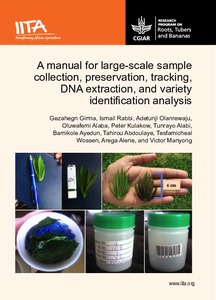| dc.contributor.author | Girma Tessema, G. |
| dc.contributor.author | Rabbi, Ismail Y |
| dc.contributor.author | Olanrewaju, A.S. |
| dc.contributor.author | Alaba, O. |
| dc.contributor.author | Kulakow, P.A. |
| dc.contributor.author | Alabi, T. |
| dc.contributor.author | Ayedun, B. |
| dc.contributor.author | Abdoulaye, Tahirou |
| dc.contributor.author | Assfaw Wossen, T. |
| dc.contributor.author | Alene, A. |
| dc.contributor.author | Manyong, Victor M. |
| dc.date.accessioned | 2019-12-04T11:08:05Z |
| dc.date.available | 2019-12-04T11:08:05Z |
| dc.date.issued | 2017-02 |
| dc.identifier.citation | Girma Tessema, G., Rabbi, I.Y., Olanrewaju, A., Alaba, O.A., Kulakow, P., Alabi, T., ... & Manyong, V. (2017). A manual for large-scale sample collection, preservation, tracking, DNA extraction, and variety identification analysis. Ibadan, Nigeria: IITA, (p. 44). |
| dc.identifier.isbn | 978-978-8444-83-1 |
| dc.identifier.uri | https://hdl.handle.net/20.500.12478/1716 |
| dc.description.abstract | Several alternative options have been used for varietal identification. However most of the traditional methods have inherent uncertainty levels and estimates often have wide confidence intervals. In an attempt to circumvent traditional survey-based measurement errors in varietal identification, DNA-based varietal identification has been implemented in the Cassava Monitoring Survey (CMS) of Nigeria — a large adoption study involving 2500 cassava farming households. The DNA fingerprinting technique offers a reliable
method to accurately identify varieties grown by farmers and increases accuracy and credibility in the interpretation of adoption rates and associated economic and policy analyses. Unlike phenotype-based methods, DNA is not affected by environmental conditions or plant growth stage and is more abundant than morphological descriptors. However, undertaking a credible DNA-based varietal identification is not a trivial matter because of the logistical challenges involving sample collection and tracking by a large team of field enumerators. This manual presents the detailed steps required for undertaking reliable DNA-fingerprinting-based identification of cassava varieties. In particular, the manual gives detailed information on the establishment of a sample tracking system, preparation of a readily available and cheap sample collection kit, field sample collection methodology, preparation of samples for DNA isolation, and
development of a pipeline for variety identification analysis. This manual is part of the outputs of the CMS project funded by the CGIAR Research Program on Roots, Tubers and Bananas (RTB), the Bill & Melinda Gates Foundation, and the International Institute of Tropical Agriculture (IITA). |
| dc.description.sponsorship | Bill & Melinda Gates Foundation |
| dc.format.extent | 32 p. |
| dc.language.iso | en |
| dc.publisher | International Institute of Tropical Agriculture |
| dc.subject | Cassava |
| dc.subject | Dna Fingerprinting |
| dc.subject | Variety Identification Analysis |
| dc.subject | Improved Cassava Cultivars |
| dc.subject | Genotyping-By-Sequencing |
| dc.subject | Sample Tracking System |
| dc.title | A manual for large-scale sample collection, preservation, tracking, DNA extraction, and variety identification analysis |
| dc.type | Manual |
| cg.contributor.crp | Roots, Tubers and Bananas |
| cg.contributor.affiliation | International Institute of Tropical Agriculture |
| cg.coverage.region | Africa |
| cg.coverage.region | West Africa |
| cg.coverage.country | Nigeria |
| cg.iitasubject | Cassava |
| cg.iitasubject | Plant Genetic Resources |
| cg.iitasubject | Plant Breeding |
| cg.howpublished | Grey Literature |
| cg.publicationplace | Ibadan, Nigeria |
| cg.accessibilitystatus | Open Access |
| local.dspaceid | 82984 |
| cg.targetaudience | Scientists |

